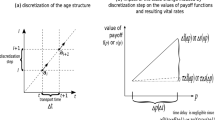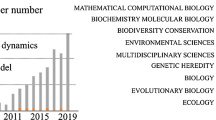Abstract
The present work is a contribution to the understanding of the sempiternal problem of the “burden of factor two” implied by sexual reproduction versus asexual one, as males are energy consumers not contributing to the production of offspring. We construct a deterministic mathematical model in population dynamics where a species enjoys both sexual and parthenogenetic capabilities of reproduction and lives on a limited resource. We then show how polygamy implies instability of a parthenogenetic population with a small number of sexually born males. This instability implies evolution of the system towards an attractor involving both (sexual and asexual) populations (which does not imply optimality of the population). We also exhibit the analogy with a parasite/host system.












Similar content being viewed by others
Notes
It is obviously possible to carry out all the ulterior developments in terms of the populations of males and females instead of sexually-born and asexually-born. According to (4) there is an equivalence between both descriptions. Biologists prefer the x and y description as it emphasizes the reproduction way instead of the sex of individuals.
References
Busch JW, Delph LF (2012) The relative importance of reproductive assurance and automatic selection as hypotheses for the evolution of self-fertilization. Ann Bot 109:553–562
De Vienne DM, Giraud T, Guyon PH (2013) Lineage selection and the maintenance of sex. PLoS ONE 8(6):e66906. doi:10.1371/journal.pone.0066906
Goodwillie C, Kalisz S, Eckert CG (2005) The evolutionary enigma of mixed mating systems in plants: occurrence, theoretical explanations, and empirical evidence. Ann Rev Ecol Evol Syst 36:47–79
Igic B, Busch JW (2013) Is self-fertilization an evolutionary dead end? N Phytol 198:386–397
Lepers C, Dufay M, Billiard S (2014) How does pollination mutualism affect the evolution of prior self-fertilization? A model. Evolution 68–12:3581–3598
Lherminier P, Sanchez-Palencia E (2015) Some remarks and examples on transient processes and attractors in biological evolution. Electron J Differ Equ Conf 22:63–77
Wright SI, Kalisz S, Slotte T (2013) Evolutionary consequences of self-fertilization in plants. Proc R Soc B 280:20130133l
Author information
Authors and Affiliations
Corresponding author
Rights and permissions
About this article
Cite this article
Sanchez-Palencia, E., Lherminier, P. & Françoise, JP. A Mathematical Model for Alternation of Polygamy and Parthenogenesis: Stability Versus Efficiency and Analogy with Parasitism. Acta Biotheor 64, 537–552 (2016). https://doi.org/10.1007/s10441-016-9293-0
Received:
Accepted:
Published:
Issue Date:
DOI: https://doi.org/10.1007/s10441-016-9293-0




